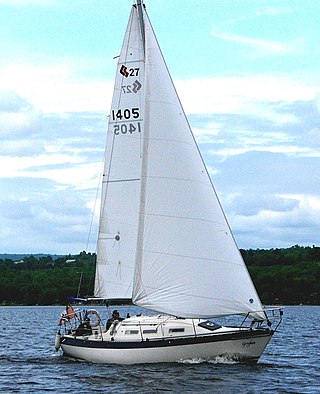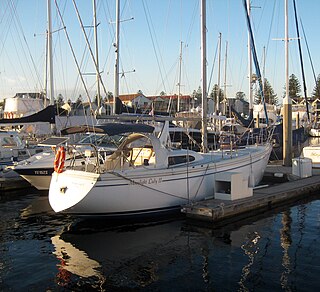Related Research Articles
The US Yachts US 25 is an American trailerable sailboat, that was designed by Gary Mull and first built in 1981. The design is out of production.

The CS 27 is a Canadian sailboat, that was designed by Raymond Wall and first built in 1975. The design is out of production.

The Fantasia 27 is a French sailboat, that was designed by Philippe H. Harlé and first built in 1981.
The Hunter 30 is an American sailboat that was designed by John Cherubini as a cruising boat and first built in 1973.
The Orion 27-2, also called the Orion 27 Mk II, is an American sailboat that was designed by Henry Mohrschladt as a cruiser and first built in 1981.
The Seafarer 30, also known as the Seafarer Swiftsure 30, is an American sailboat that was designed by McCurdy & Rhodes as a cruiser-racer and first built in 1978.
The Island Packet 27 is an American sailboat that was designed by Robert K. Johnson as a cruiser and first built in 1984.
The Island Packet 35 is an American sailboat that was designed by Robert K. Johnson as a cruiser and first built in 1988.
The Morgan 32 is an American sailboat that was designed by Ted Brewer and Jack Corey and first built in 1980.
The Watkins 32 is an American sailboat that was designed by William H. Tripp Jr as a cruiser and first built in 1982.
The Watkins 23 is an American trailerable sailboat that was designed by Johannes "Jopie" Helsen, modified by Watkins Yachts and first built in 1973.
The Watkins 27P, also known as the W27P, is an American sailboat that was designed by naval architect Walter Scott and first built in 1981.
The Watkins 36, also known as the W36 and W36AC, is an American sailboat that was designed by William H. Tripp Jr and the Watkins brothers, first built in 1981.
The Watkins 36C, also known as the W36C, is an American sailboat that was designed by William H. Tripp Jr and the Watkins brothers. It was first built in 1981.
The Watkins 29, also known as the W29, is an American sailboat that was designed by Walter Scott in conjunction with the Watkins brothers and first built in 1984.
The Watkins 25, also known as the W25 and marketed as the Seawolf 25 from 1986, is an American trailerable sailboat that was designed by the Watkins Design Team and first built in 1983.
The Com-Pac 25 is an American trailerable sailboat that was designed as a cruiser.

The Columbia 34 Mark II is an American sailboat that was designed by William H. Tripp Jr. as a coastal cruising sailboat and first built in 1970.
The Seidelmann 37 is an American sailboat that was designed by Bob Seidelmann as a racer-cruiser and first built in 1980.
The Irwin 27 is an American sailboat that was designed by Ted Irwin as a cruiser and first built in 1967.
References
- 1 2 3 4 5 6 McArthur, Bruce (2019). "Watkins 27 sailboat". sailboatdata.com. Archived from the original on 7 August 2019. Retrieved 2 November 2019.
- ↑ McArthur, Bruce (2019). "Walter Scott". sailboatdata.com. Archived from the original on 7 August 2019. Retrieved 2 November 2019.
- 1 2 3 4 5 6 7 Watkins Owners Association (20 October 2006). "Watkins W27/W27P". watkinsowners.com. Archived from the original on 13 April 2019. Retrieved 2 November 2019.
- 1 2 3 4 5 6 7 Sea Time Tech, LLC (2022). "Watkins 27". sailboat.guide. Archived from the original on 11 April 2022. Retrieved 11 April 2022.
- ↑ McArthur, Bruce (2019). "Watkins 27P sailboat". sailboatdata.com. Archived from the original on 2 October 2019. Retrieved 2 November 2019.
- ↑ McArthur, Bruce (2019). "Watkins Yachts 1973 - 1989". sailboatdata.com. Archived from the original on 2 October 2019. Retrieved 1 November 2019.
- 1 2 3 4 Watkins Owners Association (3 May 2008). "History of Watkins Yachts". watkinsowners.com. Archived from the original on 14 March 2019. Retrieved 1 November 2019.
- ↑ McArthur, Bruce (2022). "Watkins Owners". sailboatdata.com. Archived from the original on 22 March 2022. Retrieved 22 March 2022.